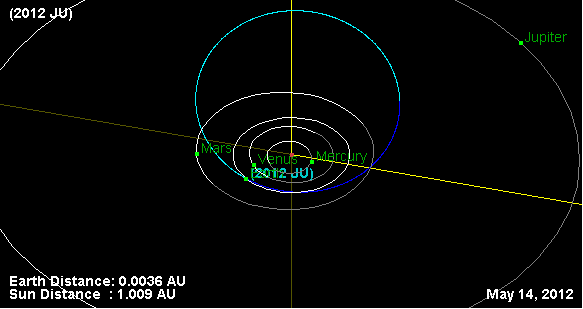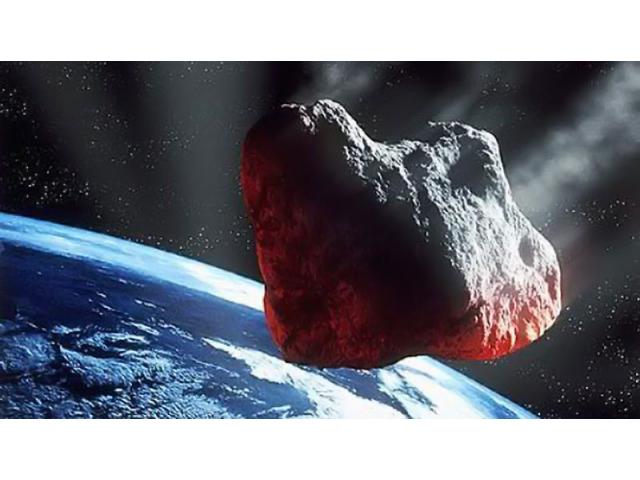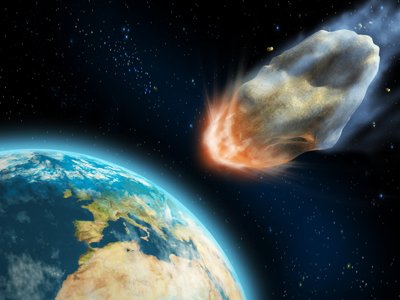Home Tags Posts tagged with "asteroid 2012"
asteroid 2012
Asteroid 2012 DA14, which is as large as an Olympic swimming pool, will race past the Earth on Friday at a distance of just 27,700 km (17,200 miles) – the closest ever predicted for an object of that size.
It will pass closer even than the geosynchronous satellites that orbit the Earth, but there is no risk of impacts or collisions.
Its closest approach will be 19:25 GMT.
For regions in darkness around that time, it will be visible using good binoculars or a telescope.
The asteroid orbits the Sun in 368 days – a period similar to Earth’s year – but it does not orbit in the same plane as the Earth.
As it passes – at a blistering 7.8 km/s (17,450 mi/hr) – it will come from “under” the Earth and return back toward the Sun from “above”.
As it does, it will pass over the eastern Indian Ocean, making for the best viewing in Eastern Europe, Asia and Australia.
But keen viewers anywhere can find one of several live streams of the event on the internet, including a feed from the Jet Propulsion Laboratory at NASA, available from 19:00 GMT.

Asteroid 2012 DA14 will race past the Earth on Friday at a distance of just 27,700 km, the closest ever predicted for an object of that size
2012 DA14 was first spotted in February 2012 by astronomers at the La Sagra Sky Survey in Spain – once a fairly small-scale, amateur effort to discover and track asteroids that has in recent years become a significant contributor to our knowledge of these “near-Earth objects”.
They caught sight of the asteroid after its last pass, at a far greater distance.
From their observations, they were able to calculate the asteroid’s future and past paths and predict Friday’s near-miss – which will be the closest the object comes for at least 30 years.
Alan Fitzsimmons of Queens University Belfast said that it is a scientific opportunity not to be missed.
“When asteroids come this close, it’s very important to try to learn about them – it’s become so bright, so it’s so easy to study,” he said.
“We get an additional insight into these small objects, which are the most likely impactors on Earth.”
[youtube pVspDvwMytM]
Asteroid 2012 JU passed within nearly 119,000 miles of Earth on May 14, just a whisker away from us in astronomical terms.
Indeed, the bus-sized asteroid came closer to us than the moon does, with our celestial partner spinning around us at a distance of 238,000 miles.
Luckily, we were never in any danger from the 12-metre wide asteroid, but it is another reminder of the risk we face from these remnants of the solar system’s early days.
NASA’s Near-Earth Object Programme, which is based at the Jet Propulsion Laboratory in Pasadena, California, tracks the bullets from space.

Asteroid 2012 JU passed within nearly 119,000 miles of Earth on May 14, just a whisker away from us in astronomical terms
They put together an animation of 2012 JU’s orbit, showing how the asteroid swings towards Earth, having spent the last two months travelling towards us from Mars.
After its brief fly-by of our planet, allowing any space aliens on a Greyhound tour to take their space-photos of our little blue marble, the asteroid heads out towards the orbit of Jupiter.
Then the sun’s gravity pulls it back towards to centre of our solar system, and it sweeps round on another tour of the inner planets.
Earth gets asteroid fly-bys all the time from asteroids, with the NASA researchers doing their best to track as many as possible.
They are currently tracking 8,900 near-Earth asteroids, hoping to spot any threats to our planet before they arrive, like the asteroid which wiped out the dinosaurs 65million years ago.
[youtube ZRLQiPJWHQk]
Asteroid 2012 DA14, a 150-foot space rock orbiting Earth, will pass closer than geostationary satellites to our planet on February next year.
NASA’s Impact Risk report said that the odds of the space rock actually hitting Earth are very low indeed – but on February 15, 2013, it will pass just 17,000 miles from Earth, closer than “geostationary” satellites.
If an asteroid of that size hit Earth, it would cause an explosion similar to a nuclear blast.
Two astronomers from the Observatorio Astronómico de La Sagra in Spain spotted 2012 DA14 in late February and its orbit has been calculated to be very similar to Earth’s.
Some reports suggested that on February 15 next year an impact was a possibility, but U.S astronomer Phil Plait, the creator of the Bad Astronomy blog, has ruled out an impact.
Phil Plait wrote: “Asteroid 2012 DA14 is almost certainly not going to hit Earth next February. And by <<almost certainly>>, I mean it. The odds of an impact are so low they are essentially zero. This does not rule out an impact at some future date, but for now we’re safe.”

Asteroid 2012 DA14, a 150-foot space rock orbiting Earth, will pass closer than geostationary satellites to our planet on February next year
The asteroid will come within 17,000 miles of Earth, which is closer than some of our satellites, but Phil Plait says this is nothing to worry about.
The astronomer adds: “Seventeen thousand miles is well beneath many of our own orbiting satellites. To the best of my knowledge, this is the closest pass of a decent-sized asteroid ever seen before the actual pass itself. However, let’s again be very clear – it will miss. In astronomical terms, 17,000 miles is pretty close, but in real human terms it’s a clean miss.”
After 2013, 2012 DA14’s closest brush with Earth will come in 2020, but Phil Plait said that even then the odds of an impact will be less than the chance of being hit by lightning in your lifetime – 1 in 100,000.
What are the chances of a major impact?
NASA’s latest scan for “impact event” threats used the Wide-field Infrared Survey Explorer, or WISE and took two infrared scans of the entire celestial sky between January 2010 and February 2011.
The scan aimed to find asteroids and comets “near Earth” – i.e. within 120 million miles.
The scan found there are 20,500 asteroids and comets that could destroy a city-sized area within 120 million miles of earth – previously the figure was thought to be 36,000.
NASA says the risk of impact is less than previously thought. The likelihood of a “planet-killer” – the mountain-sized asteroids in the “large-sized” range, above 3,300ft – appears to have fallen more significantly.
There are only 981 of these objects near Earth, and NASA has found 911 of them.
NASA announces that an asteroid the size of a bus is set to pass extremely close to Earth today.
Asteroid 2012 BX34 will pass within 36,750 miles of Earth at about 3:30 p.m GMT/10:30 a.m. EST Friday, January 27, tweeted astronomers with NASA’s Asteroid Watch program.
Even though this is more than five times closer than the moon, at 11 meters wide, the rock won’t be any threat to Earth.
“It wouldn’t get through our atmosphere intact even if it dared to try,” Asteroid Watch scientists tweeted Thursday.
Asteroid Watch is a part of NASA’s Jet Propulsion Laboratory in Pasadena, California.

NASA announces that an asteroid the size of a bus is set to pass extremely close to Earth today
For an asteroid to cause real damage to Earth, it needs to measure at least 140 m, experts estimate.
At that size they can cause widespread destruction near where they hit but will need to be far larger to cause trouble globally.
With this danger in mind, scientists in Germany have just launched a study to develop an asteroid shield.
With funds from the European Commission, the NEOShield project is expected to take three years to complete.
Some of the scientists will look at include repelling asteroids with projectiles or explosives or using gravity to change its course.
Still today’s asteroid passing should offer a good show:
“Advanced amateur astronomers might be able to observe the flyby as the asteroid brightens to 14th magnitude just before closest approach on Friday,” the website Spaceweather.com reported.




